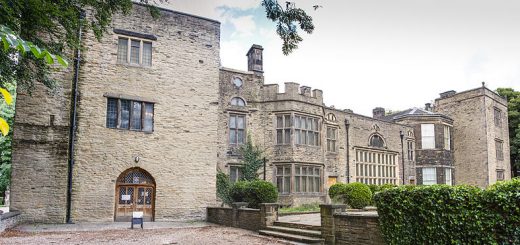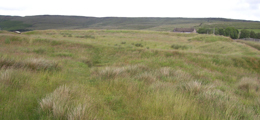Lostock Tower
The Grade II listed Gatehouse, a private residence, is all that now remains of Lostock Hall, a moated manor house demolished between 1816 and 1824. Lostock Hall was the ancestral home of the Anderton family. The following account of a story associated with Lostock Hall, or Lostock Tower as it is referred to, was published in The Haunted Homes and Family Traditions of Great Britain by John Ingram (1897).
‘Lostock Tower, about four miles to the west of Bolton, is one of the numerous haunted homes of Lancashire. It figures in Roby’s well-known Lancashire Legends as the locality of a cruel wrong, and proves that apparitions have more regard for moral than legal rights. The Tower was formerly an imposing structure, built chiefly of wood and plaster, and surrounded by a moat. The gateway, which occupies the site of a much more ancient building, is now almost all that is left of the Anderton’s old homestead. It is chiefly “built of brick and stone, interspersed with string courses and mouldings. The windows are very large, and are divided into compartments by strong mullions.”
“Over one of the upper windows,” writes Mr. Wilkinson, “there is a deep panel containing a coat of arms, now almost obliterated. On the front of the house there is the date ‘a.d. 1591’; and a panel over the doorway, on which is the inscription ‘S. F. A. 1702,’ obviously marks the period when this portion of the Hall was either enlarged or repaired. This characteristic residence was not very judiciously situated, according to modern ideas. There is much low ground in the neighbourhood, which contains several rather picturesque sheets of water, and it is, besides, in the immediate vicinity of the boggy tract known as Red Moss. The river Croal rises from this marshy ground, which, after passing through Bolton, falls into the Irwell; the far-famed Douglas, also, has its origin in the same Moss, and, after flowing through Wigan, falls into the Kibble near Hesketh.
“Lostock Tower formerly belonged to the Andertons, but has since merged into the hands of the Blundells of Ince. There is a story of wrong connected with one of the early Andertons, which has passed into a tradition, and is even yet a source of heart-burning to a family named Heaton, resident in a neighbouring township of the same name. This tradition states that one of the Heatons was an improvident man, and wasted much of his patrimony. He became deeply involved in debt, and mortgaged his township to Anderton of the Tower. The day for payment duly arrived, but the Heatons had not raised the money. The evening passed on, and at a somewhat early hour the Andertons retired to bed. They had not lain long before the Heatons were thundering at the doors; for they had raised the amount at the last moment, and were ready to pay. The owner of the Tower, however, coveted the property, and refused to let them in, because they ought to have been ready before the going down of the sun. On the morrow he said they were too late, and declared that the mortgage was foreclosed.
“The wrong done to the Heatons was never forgiven, for the family was utterly ruined; and it is stated that the soul of the wrongdoer is doomed to revisit the scene of his crime until the property is restored. It is also affirmed that no horse from the Tower, so long as it was occupied by an Anderton, could ever be forced to cross the stream into the manor of Heaton. Sir Francis Anderton took part in the Rebellion of 1745, and soon after lost his estates. In 1750 he was reported to be over sixty years of age, and childless; his property was held by the Crown under trustees, and eventually passed to the Blundells, he living in retirement until his death. This gentleman’s fate is considered to be an act of retributive justice for the wrong done to the Heaton family by his ancestor of the Tower. ‘




Re: Lostock Tower
Lostock township stretches over 2 miles from east to west, and has an area of 1,520 acres. It lies between higher lands to the north and south, and through the slight depression flows the Croal eastward. The boundaries appear arbitrary, except for the Red Moss which separates it from Blackrod, and a brook tributary to the Croal which divides it from Heaton. The principal hamlet is Chew Moor, in the south-east corner; another is Lostock Hall Fold, near the centre of the northern border, where a suburb of Bolton is growing up. The population was 852 in 1901.
During the 12th century LOSTOCK was with the adjoining Rumworth a member of the Manchester barony, and the two were by the younger Albert Grelley given to Thomas de Pierpoint as the third part of a knight’s fee. Together they were assessed as three ploughlands, Lostock by itself being one. Richard de Pierpoint, the heir of Thomas, held both in 1205, and probably in 1212; he was a benefactor of Cockersand Abbey. Afterwards they descended to Thomas de Pierpoint, who was twice married; by his first wife Margery he left a daughter Alice, and by his second, Margaret, a son and heir Richard and a daughter Ameria. Richard succeeded his father, but died without issue; whereupon Ameria, wife of William de Anderton, claimed as sole heir of her brother, the elder sister, being only of the half blood, not having a share. The Hultons succeeded. Their inheritance was afterwards divided; Lostock became a manor of the Athertons of Atherton, and was sold by Sir John Atherton in 1562 to Christopher Anderton.
The new owner, son of Lawrence Anderton, was a lawyer. In religion he went with the times, at least externally, being engaged in making a great fortune; but his wife adhered to the Romish faith. He died at Lostock 5 May 1592, holding the manors of Lostock, Heaton-under-Horwich, and Tyldesley, and messuages, mills, and lands in these townships and many others in South Lancashire. James Anderton, the son and heir, was thirty-five years of age. He was ‘backward in religion,’ and ‘his wife a recusant.’ He obtained the rectories of Eccles and Deane. He had no children, and his estates on his death in 1613 passed to a younger brother Christopher, who died in 1619. In 1615 the twothirds of Christopher’s manors and lands sequestered for his recusancy were granted by the king on lease to Patrick Malde and Henry Gibb. In the inquisitions cited the manors and lands in Lostock, Heaton, and Horwich are not distinguished, the whole being held of the lord of Manchester in socage by a rent of 22s. 7d.; the knight’s service had been placed upon Rumworth alone.
Anderton of Lostock.Sable three shacklebolts argent, a mullet or for difference.
Early in the 17th century a secret printing-press at Lostock Hall issued a number of Roman Catholic books, devotional and controversial. It was afterwards removed to Birchley, near Wigan.
Christopher Anderton left a son and heir of the same name, who was nearly twelve years of age at his father’s death, but had already been married to Agnes daughter of John Preston, of the same age as himself. Three years later the heir went to Douay, but stayed less than eighteen months, being ‘not inclined to study.’ On the outbreak of the Civil War he, like others of the old religion, espoused the royal cause, but appears to have grown tired of it, and was imprisoned for refusing to act for the king; he then fled into Wales and escaped to France. His estates were, however, sequestered by the Parliament ‘for popery and delinquency,’ and he had not regained possession at his death on 7 July 1650. His widow Alethea and the son and heir Francis also petitioned the Commonwealth authorities. Francis, having for the time renounced his religion, had the estates granted to him. He acquired the manor of Anderton in 1668, and was created a baronet in 1677, and dying in Paris the following year was buried there in the chapel of the English Benedictines, St. Edmund’s.
Charles, the eldest son, in 1675 married Margaret daughter and heir of Lawrence Ireland of Lydiate. After his father’s death he resided at Lostock, and his widow and then his son Francis continued there till about 1715, when owing to the forfeiture the hall ceased to be the family residence, and was partly taken down a century later. The manor continued in the hands of the Andertons and Blundells of Ince till Sir Charles was buried under the communion table in Bolton Church, but no monument was allowed by the authorities,. Scholes and Pimblett, Bolton, 157–8. 1810, when by the will of Henry Blundell the Lostock estates were bequeathed to his daughters, Katherine wife of Thomas Stonor of Stonor, and Elizabeth wife of Stephen Tempest of Broughton. (fn. 34) The estates were divided, and Lostock was joined with Anderton as part of the Stonor share and descended with it, but has recently been sold by Mr. Charles Joseph Stonor. No manor is claimed.
The partition of the Lostock estates was made in 1819 under a private Act, but possession was delayed by lawsuits until 1830. In 1821 John Anderton, a publican of Colne, made claim to them, alleging that he was heir under a settlement by Sir Charles Anderton in 1685, by which there was a remainder to a brother John. Plaintiff was brother of Francis Anderton (d. 1804) and son of a John Anderton, who was son of the Rev. John Anderton (d. 1742), supposed by the plaintiff to have been the brother of Sir Charles, and to have been disinherited because he became a Protestant. It was proved, however, that he was a son of Stephen Anderton of Hardhill in Clitheroe, and therefore a cousin, not brother, of Sir Charles.
Of Lostock Hall only the gatehouse remains. The hall is described by Britton in 1807 as ‘formed of wooden beams and plaster. Over the entrance door are the initials of the persons who lived here, with the date when it was built, CAD 1563. Most of the rooms are wainscoted with many panels.’ The drawing in Philips’s Views of Old Halls of Lancashire and Cheshire shows a half-timbered house with four overhanging timber gables in the principal front, the lower portion built in either stone or brick. Another of Philips’s drawings in the same book shows three gables only, the large southern one having presumably been destroyed. These sketches can, however, only be relied on as giving a fair general idea of the appearance of the house, as his drawing of the gatehouse is wrong in many particulars. The hall, which had long been used as a farm-house, was partly pulled down about 1816, and finally disappeared some eight years later.
The gatehouse, which stood at some little distance east of the hall, is still in existence. It is a stone building of three stories with a staircase tower at its north-west angle. Its main front, which is of ashlar, faces east, and is about 45 ft. in length and 33 ft. high, the depth from front to back being about 22 ft. 6 in. In the ground stage is a centre archway, and above it in the two upper stages mullioned and transomed windows of eight lights each, the archway and windows being flanked on each stage by pairs of widely-spaced columns. Those in the ground stage are of the Tuscan order, and the others of the Ionic and Corinthian orders respectively. Between each stage are wide strings taking the form of cornice, frieze, and architrave, and breaking out over the columns, the cornices only continued as strings all round the building. The detail of the whole composition is poor, but it shows a far more pronounced Renaissance spirit than is usually found in this part of Lancashire. The gateway is now built up and a modern doorway inserted. There were originally no windows on the ground floor, but two modern sash windows have been introduced between the columns, one on each side. Over the large window on the first floor is a square panel with the arms of Anderton surmounted by helm, crest, and mantling, and over the second floor window is a similar panel with a shield bearing the royal arms of Queen Elizabeth, with the date 1591 and the royal initials E.R. The upper cornice is crowned with a scalloped parapet with traces of finials on the alternate crenals. The frieze of the second order is ornamented with hollow flutes, and the others are plain. The other three sides of the building are faced with thin coursed rubble. The west arch of the gateway is also built up, but otherwise this face of the building preserves a good deal of its original appearance, having six mullioned windows, the lower ones with hood-moulds. On the south side the original windows remain on the first and second floors, but sash windows have been inserted on the ground story. On the north side the original window on the ground floor is built up, but those to the first and second floors remain. The staircase wing at the north-west corner is built of rough thin-coursed stones and has its original windows; but the top of the tower, which formerly seems to have terminated in an octagonal turret with conical roof, has disappeared, and it is now finished with a plain pent roof from the level of the upper cornice. The original chimney-stacks, too, have disappeared, and have been replaced by plain modern shafts. The roof is covered with lead. There is a range of buildings beyond the staircase tower on the north-west corner of the house extending westward, but this was erected as late as 1810. The gatehouse is now used as a farm-house, and the interior has nothing of interest; the original gateway, which is 7 ft. wide, is thrown into the house, partly forming an entrance lobby. On the frieze immediately over the gateway was, till recently, a lead panel with the initials s. f. a. and the date 1712, now nailed against a wooden outbuilding on the south side of the house. It measures 16 in. by 12 in., and looks like the front of a spout-head.
A portion of Lostock descended, with other Hulton estates, to the Radcliffes and Bartons of Smithills in Halliwell.
[‘Townships: Lostock’, A History of the County of Lancaster: Volume 5 (1911)]